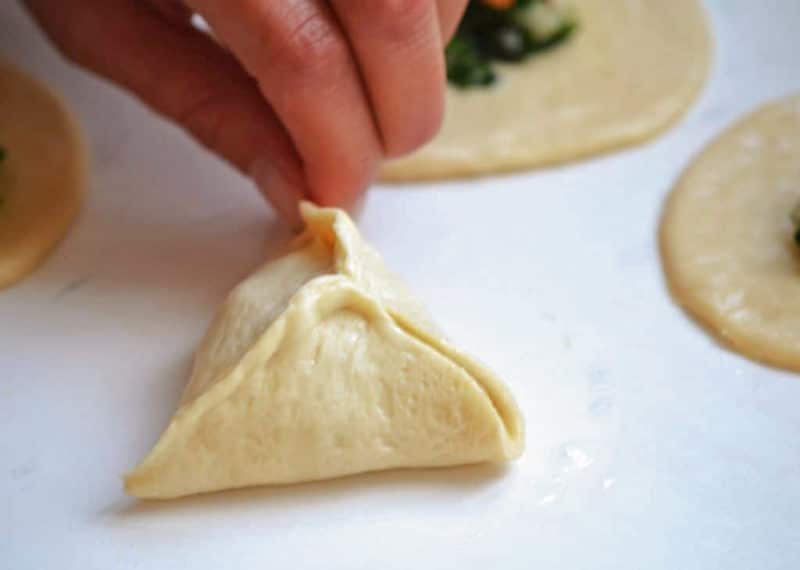How to shape fatayer so they won’t open up.
May 15, 2020, Updated Sep 27, 2023
This post may contain affiliate links. Please read our disclosure policy.
Here are the tricks you need to learn how to shape Lebanese Fatayer so they won’t open up when they bake! These little savory hand pies, can be a challenge to hold their classic triangle shape without opening at the seams. Here’s how to shape fatayer so they won’t open up!

The big challenge anyone who has ever baked fatayer knows is this: how to shape those little ditties so they have a lovely triangle shape. And more importantly: how to keep the fatayer closed. There are three seams atop the fatayer triangles. In the absence of mortar, Krazy glue, or staples, those seams like to open when pressured by the steam the filling creates as it bakes.
I’ve made rigorous study of this problem (opportunity?), which you can read about here. The results of my ongoing inquiry (baking tons of fatayar) remain the same.
Here’s how to shape fatayar, using three key factors to help keep your fatayar closed.
1. Keep the dough sticky while filling.
We’ve worked to create a sticky dough, now we’ve got to keep it that way while we roll, fill, and shape the fatayer. How? Work swiftly, my friends. This isn’t the time to indulge distractions. Turn off all phone sounds and get to it. Roll out the dough, cut the circles, remove the scraps, carefully place the filling (see #2 below!).

2. Shape with extra care. And pinch as hard as you can.
The triangle is made by pulling three points on the perimeter of the cut dough circle UP AND OVER THE FILLING. These three points meet with a hard pinch at the top center above the filling. Finesse this by not allowing these edges that will be pinched together to touch the filling as you pull them up and over. The filling’s juices and oils are avoided because they serve to prevent the dough edges from connecting.
Once closed, gently pick up your closed fatayer triangle and push it into shape, pinching the seams again, then place it on your oiled sheet pan and hard-pinch the seams closed again. I’m not saying this is easy or that my every fatayer shape achieves perfection in the shaping. But . . . this works to keep the seams closed.

3. Use a dryer filling.
This means your frozen or fresh chopped spinach (a classic filling) must drain off as much liquid as possible. I’ve started using lemon crystals or citric acid in place of lemon juice, which is a great way to keep the moisture level down. Many recipes call for sumac rather than lemon, which imparts that tangy flavor without the liquid. Don’t worry that your filling will be dry in the end result after baking; it’s always moist and delicious even when taking these steps to keep it dryer for shaping. Be sure when placing the filling on the dough that it doesn’t touch anywhere on the perimeter of the circle. Any moisture from the filling on this perimeter will prevent the seams, once closed, from staying closed.

For meat filling using beef or lamb, the same holds true except that it’s more challenging to find ways to keep this filling dry. A lower fat meat grind helps. Typically, though, meat-filled fatayer are open-face or have a vent opening at the top. These are sfeha (little open-faced meat pie squares) or laham bi ajeen (a flat bread with meat topping). The recipe for sfeha is in my cookbook. I’m on a continued quest to shape perfect square sfeha that stay that way when baked, so if anyone has the magic (a different dough recipe for this?), please chime in!!

Recipes for Fatayer
Lebanese Squash or Koosa Fatayer
Lebanese Feta and Kale Fatayer











Thanks for the closing hints. But, I have a question. Why can’t the spinach filling be first cooked slightly? I made my first batch recently, and I didn’t have an actual recipe. So I did what I thought was right by cooking the filling first. They baked nicely with no juice running out.
Also, if using lemon crystals instead of juice, how much would you suggest?
Great question Jean. 1 tablespoon lemon juice = 1/2 teaspoon lemon crystals. The spinach can be cooked first but it causes a lot of juice unless it is squeezed, drained, or sauteed dry to prevent the juice from getting on the dough and making it difficult to close. Sounds like yours went well which is wonderful!
Where do you find lemon crystals, and what is the quantity of lemon crystals or citric acid to replace the lemon juice?
1/2 teaspoon lemon crystals = 1 tablespoon lemon juice. Great question thank you!
Your dough recipe is by far the best!!i I tried many recipes prior to yours but now I am sticking to this one!! Thank you!!
I’m so happy to hear that Lina, thank you!